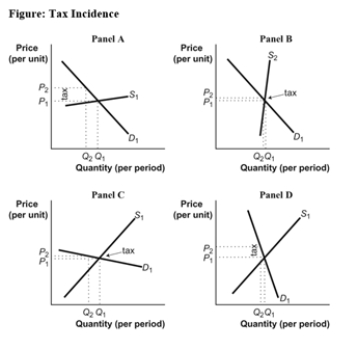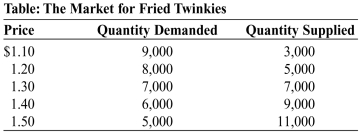A) increase by more than $4.
B) increase by exactly $4.
C) increase by less than $4.
D) remain constant.
Correct Answer

verified
Correct Answer
verified
Multiple Choice
Use the following to answer question:  -(Table: Taxes,Spending,and Income) Use Table: Taxes,Spending,and Income.Suppose Governor Meridias decides to initiate a state tax of 5% on all sales.A poor household will spend _____% of its annual income on the sales tax,while a wealthy household will spend _____% of its annual income.
-(Table: Taxes,Spending,and Income) Use Table: Taxes,Spending,and Income.Suppose Governor Meridias decides to initiate a state tax of 5% on all sales.A poor household will spend _____% of its annual income on the sales tax,while a wealthy household will spend _____% of its annual income.
A) 4.5;4
B) 5;5
C) 5;3.5
D) 3.5;4.5
Correct Answer

verified
Correct Answer
verified
Multiple Choice
The government imposes a tax of $1,000 per household to fund a new public swimming pool.This tax is:
A) regressive.
B) proportional.
C) progressive.
D) flat.
Correct Answer

verified
Correct Answer
verified
True/False
Economic policies often involve trade-offs between efficiency and equity.Fortunately,tax policy is an exception because it is easy to find taxes that are both efficient and fair.
Correct Answer

verified
Correct Answer
verified
Multiple Choice
A _____ tax takes a larger share of the income of high-income taxpayers than of low-income taxpayers.
A) sales
B) regressive
C) progressive
D) flat
Correct Answer

verified
Correct Answer
verified
Multiple Choice
Use the following to answer question:  -(Table: Taxes,Spending,and Income) Use Table: Taxes,Spending,and Income.Suppose Governor Meridias decides to initiate a state tax of 5% on all sales.This tax will be:
-(Table: Taxes,Spending,and Income) Use Table: Taxes,Spending,and Income.Suppose Governor Meridias decides to initiate a state tax of 5% on all sales.This tax will be:
A) progressive.
B) proportional.
C) regressive.
D) structural.
Correct Answer

verified
Correct Answer
verified
True/False
Lump-sum taxes promote economic efficiency but violate the ability-to-pay principle.
Correct Answer

verified
Correct Answer
verified
Multiple Choice
Use the following to answer question:  -(Figure: Tax Incidence) Use Figure: Tax Incidence.Producers are likely to bear more of the burden of an excise tax in the situations illustrated by panels:
-(Figure: Tax Incidence) Use Figure: Tax Incidence.Producers are likely to bear more of the burden of an excise tax in the situations illustrated by panels:
A) A and B.
B) A and C.
C) B and D.
D) B and C.
Correct Answer

verified
Correct Answer
verified
Multiple Choice
Producers in a particular market will bear the greater burden of an excise tax:
A) the more price-elastic the demand is relative to supply.
B) the less price-elastic demand is relative to supply.
C) if demand has the same price elasticity as supply.
D) regardless of the price elasticity of demand or supply.
Correct Answer

verified
Correct Answer
verified
Multiple Choice
The demand for food is very inelastic compared to the supply of food,so if a tax is imposed on the consumers of food,the tax incidence:
A) is typically on consumers more than producers.
B) is typically on producers more than consumers.
C) is typically split equally between consumers and producers.
D) cannot be determined without more information.
Correct Answer

verified
Correct Answer
verified
Multiple Choice
Use the following to answer question:  -(Table: The Market for Fried Twinkies) Use Table: The Market for Fried Twinkies.As a result of the $0.30 tax per fried Twinkie,the government will receive total tax revenue of:
-(Table: The Market for Fried Twinkies) Use Table: The Market for Fried Twinkies.As a result of the $0.30 tax per fried Twinkie,the government will receive total tax revenue of:
A) $500.
B) $1,000.
C) $1,500.
D) The total is impossible to calculate.
Correct Answer

verified
Correct Answer
verified
Multiple Choice
State governments levy excise taxes on alcohol because:
A) they want to subsidize alcohol production.
B) they want to encourage individuals to produce their own alcohol.
C) it discourages drinking alcohol while raising revenue for the government.
D) it is politically popular with religious groups.
Correct Answer

verified
Correct Answer
verified
Multiple Choice
An analysis of the effect of excise taxes on markets allows us to conclude that:
A) when the price elasticity of supply is equal to zero,an excise tax falls entirely on the consumers.
B) when the price elasticity of demand is lower than the price elasticity of supply,an excise tax falls mainly on the producers.
C) whether the tax is levied on consumers or producers,the quantity sold will be the same.
D) when the price elasticity of demand is higher than the price elasticity of supply,an excise tax falls mainly on the consumers.
Correct Answer

verified
Correct Answer
verified
Multiple Choice
If the elasticity of demand is _____ and the elasticity of supply is _____,tax revenue is likely to increase if the tax rate is increased.
A) 3.3;2.1
B) 3.3;0.5
C) 0.2;2.1
D) 0.2;0.5
Correct Answer

verified
Correct Answer
verified
Multiple Choice
By law,FICA (the Federal Insurance Contributions Act) ,a payroll tax,is collected equally from employers and employees.In reality:
A) the law works since the employers and the employees each bear half of the burden of the tax.
B) the employees bear almost all of the burden of the tax.
C) the employers bear almost all of the burden of the tax.
D) it's impossible to determine who bears the burden of the tax.
Correct Answer

verified
Correct Answer
verified
Multiple Choice
Suppose Governor Meridias decides to initiate a state income tax.The first $50,000 of household income is tax-free,while any income above $50,000 is taxed at 10%.The marginal tax rate for a household earning $75,000 is:
A) greater than its average tax rate.
B) less than its average tax rate.
C) equal to its average tax rate.
D) 3.3%.
Correct Answer

verified
Correct Answer
verified
Multiple Choice
The _____ rate on income represents the additional tax an individual pays if his or her income goes up by $1.This rate has _____ since 2000.
A) tax;increased
B) marginal tax;decreased
C) marginal tax;increased
D) tax;decreased
Correct Answer

verified
Correct Answer
verified
Multiple Choice
If the government wants to minimize the deadweight loss from taxes,it should tax goods for which the:
A) price elasticity of demand is high.
B) price elasticity of demand is low.
C) price elasticity of supply is high.
D) demand is high.
Correct Answer

verified
Correct Answer
verified
True/False
The FICA tax falls most heavily on workers because the price elasticity of demand for labor is greater than the price elasticity of supply of labor.
Correct Answer

verified
Correct Answer
verified
Multiple Choice
Use the following to answer question:  -(Figure: Tax Incidence) Use Figure: Tax Incidence.All other things unchanged,when a good or service is characterized by a relatively inelastic demand,as shown in panel _____,the greater share of the burden of an excise tax on it is borne by _____.
-(Figure: Tax Incidence) Use Figure: Tax Incidence.All other things unchanged,when a good or service is characterized by a relatively inelastic demand,as shown in panel _____,the greater share of the burden of an excise tax on it is borne by _____.
A) C;buyers
B) C;sellers
C) D;sellers
D) D;buyers
Correct Answer

verified
Correct Answer
verified
Showing 21 - 40 of 286
Related Exams